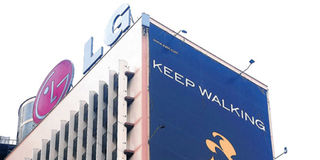Brands outdo each other with outdoor ads

Companies are increasingly innovating in their outdoor marketing strategies as they seek to capture the consumer’s attention. Photo/DENISH OCHIENG
What you need to know:
- International firms have made a beeline for Nairobi with an eye on the region for a share of the economic boom. All these companies are trying to court a growing middle class consumer base.
LG Electronics has branded Teleposta Towers, a strategy that is reflective of the bruising battle that companies are fighting in the outdoor advertising space to capture the consumer’s eye.
The South Korean giant has no links to Teleposta Towers. In fact, the local LG Electronics head office is five kilometres away at Riverside Drive. Placing a gigantic LG logo that sends no specific message atop Teleposta Towers is 10 times more expensive than buying space for a regular billboard.
However, the signage is part of a global initiative to step up its outdoor visibility in a market that is awash with global brands. In the middle of this fight, it is getting difficult for brands that are not innovative in their outdoor advertising to get noticed.
“Competition is becoming stiffer and there is constant pressure to stand out from the crowd. You can no longer do that with a regular billboard,” said LG Electronics’ regional marketing manager Daisy Mugo.
Construction zones
A walk through Nairobi’s central business district will reveal a range of outdoor advertising strategies that were largely absent from the market a decade ago.
LED screens have been put up on Uhuru Highway and Moi Avenue. Outdoor advertising company ENG is branding city benches while its rival, Magnate Ventures, in partnership with the county government, is branding street signage.
Construction zones across the city have become highly sought-after advertising spots. The battle has also spilled over to hypermarkets, where firms are putting their ads on LED screens.
“The outdoor advertising space is cluttered and fragmented. More and more clients are starting to ask for iconic sites that are visible and that create a buzz,” said Ms Eva Muchai, the general manager of local media-buying company, Mindshare.
She said that at least 70 per cent of her clients were now requesting outdoor advertising strategies that are “out of the box”. The media-buying and advertising sector is, in turn, growing more sophisticated in order to meet changing customer demands. A host of local and foreign companies are making money installing and selling space on outdoor LED screens and signs around the city.
Growth in the outdoor advertising segment is in line with a positive regional and local economic outlook. Kenya’s economy is projected to post a five per cent jump this year. This rate is matched or surpassed by other economies in the East African Community.
International firms have made a beeline for Nairobi with an eye on the region for a share of the economic boom. All these companies are trying to court a growing middle class consumer base.
At the same time, advances in technology have partially eroded consumer exposure to traditional forms of advertising.
Audiences can now look forward to television ads while some newsreaders are dumping the newspaper in favour of the Internet for their daily dose of current affairs.
On the other hand, outdoor advertising remains “virtually immune to consumer avoidance. It can’t be turned off, flipped to the next page, or thrown away.”
Important medium
“Outdoor is still an important medium among brands that want to make a statement in the market. It is difficult for a brand to be seen as big without outdoor advertising,” said the Posterscope managing director, Mr George Mugendi.
Posterscope develops out-of-home media strategies for companies. The firm’s research has shown that people are increasingly spending more time out and about, with about 65 per cent of their waking hours outside the home. Since waking hours are the only opportunity for advertisers to engage their audience, the power of outdoor advertising is, therefore, boosted.
Additionally, Posterscope indicates that outdoor advertising is crucial to a trend of media convergence in the advertising space. Companies developing media communication plans have to consider how such a plan will translate in television, social media, radio, mobile phone, print, and outdoors. It is also important that each of these mediums complement and feed each other.
“Outdoor is the medium which has been identified as driving the most people towards social media pages,” said Mr Mugendi.
Despite these developments, outdoor marketing over digital media is yet to pick up in Kenya and East Africa as it has elsewhere in the world. Although more cost-effective and versatile than static outdoor media, this medium is not as popular among local companies.
In more mature markets, digital advertising in public places has become a money-maker for media-buying agencies.
According to an article published in The Economist in January, advertising on digital screens accounted for 20 per cent of Britain’s outdoor advertising revenue last year. In the US, it accounted for about one per cent but is set to grow by more than four per cent this year.
Out-of-home digital advertising has been successful in the United Kingdom, partially because companies have learnt to leverage on data in order to target niche markets with the products. Specific ads are targeted at train and bus passengers while companies analyse neighbourhood demographics before advertising their brands in malls and hypermarkets.
Digital screens are also used to carry out market research. Some have been fitted with cameras to monitor the age and gender of the people whom they draw. Wi-Fi installed on the digital screens allows passers-by to find out more about products.
Soon, according to The Economist, they will be able to shop simply by interacting with outdoor advertising.




